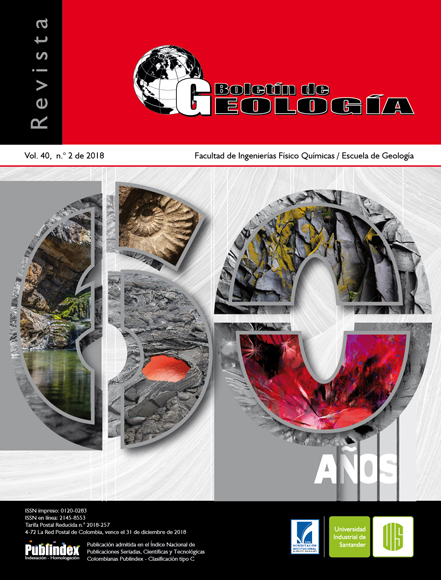Isostatic state of fan Magdalena river from the interpretation of potential filds anomalies, Colombia Basin
Published 2018-06-06
Keywords
- Caribbean plate,
- gravity method,
- magnetic method,
- isostasy,
- Magdalena delta
- Colombia Basin ...More
How to Cite
Altmetrics
Abstract
The main purpose of this research is to clear up the isostatic state of the fan area of the Magdalena River from the interpretation of gravity and magnetic anomalies of the Colombia Basin in order to improve the theoretical knowledge on the geodynamic processes and the phenomenon of isostasy. Previous research suggests that the isostatic condition of the crust is strongly affected by the correlation between Free Air Gravity Anomalies (FAGA) and Terrain Gravity Effects (TGE).
The analysis and interpretation include processing and mapping of gravity and magnetic anomalies. Correlations and interpretations of gravimetric anomalies confim isostatic perturbations along the Colombian northwestern margin and the Colombia Basin. The validation of the results was done through the forward and inverse modeling from gravity and magnetic data and subsequent comparison with models of crust thickness from seismic data. The models suggest a low subduction angle and elastic deformation of the Caribbean plate, which is affected by the sedimentary load of the paleo-delta of the Magdalena River, the geo-tectonic provinces of the Sinú-San Jacinto belt and the continental crust.
Downloads
References
Hinze, W., von Frese, R., and Saad, A. (2013). Gravity and magnetic exploration: Principles, practices and applications. Cambridge: Cambridge University Press.
Kearey, P., Klepeis, K.A., and Vine, F.J. (2009). Global tectonics. 3rd edition. New York: WileyBlackwell.
Kolla, V., Bufflr, R.T., and Ladd, J.W. (1984). Seismic stratigraphy and sedimentation of Magdalena Fan, Southern Colombian Basin, Caribbean Sea. American Association of Petroleum Geologists Bulletin, 68(3), 316-332.
Merriam, D.F., and Sneathh, P.H. (1966). Quantitative comparison of contour maps. Journal of Geophysical Research, 7(4), 1105-1115. doi: 10.1029/JZ071i004p01105.
Pince, J.M., Osorio, C., Mouly, B., and Amaral, J. (2003). Tertiary depositional environments and reservoir properties in the Sinu accretionary prism (offshore - Colombia). VIII Simposio Bolivariano - Exploración Petrolera en las Cuencas Subandinas. Cartagena, Colombia.
Pirmez, C., Breen, N.A., Flood, R.D., O’Connell, S., Jacobi, R.D., Ladd, J.W., Westbrook, G., Franco, J.V., and Garzon, M. (1990). Gloria mosaic of the Magdalena deep-sea fan, Northern Colombian convergent margin. American Association of Petroleum Geologists, 74(5), 741.
Romero-Otero, G., Slatt, R., and Pirmez, C. (2015). Evolution of the Magdalena deepwater fan in a tectonically active setting, Offshore Colombia. In: C. Bartilini, and P. Mann (Ed.). Petroleum geology and potential of the Colombian Caribbean Margin (pp. 675-708). Vol. 108. Texas: American Association of Petroleum Geologists.
von Frese, R.R., Jones, M., Kim, J., and Kim, J. (1997). Analysis of anomaly correlations. Geophysics, 62(1), 342-351. doi: 10.1190/1.1444136.
Watts, A.B. (2001). Isostasy and flxure of the lithosphere. 1st edition. New York: Cambridge University Press.

